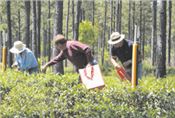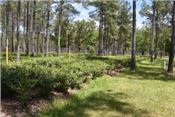It Could Be Tea Time In Louisiana Soon

David Barron, center, is picking tea leaves on his farm near Amite City with two visitors. Barron planted tea plants from
the Republic of Georgia two years ago and is starting a commercial operation centered around the tea plants.
Photo by Yan Chen/LSU AgCenter
HAMMOND, LA.
While tea is consumed globally, its production is focused mainly in Asia. A scientist with the LSU AgCenter has a research plot at the Hammond Research Station and is examining if certain varieties can be commercially grown in Louisiana.
Yan Chen, a horticulturist, is managing a plot of several tea varieties at the station. She is looking at the adaptability of the plants to Louisiana’s environment, especially the plants’ cold hardiness and heat tolerance.
“Tea can definitely be grown in Louisiana,” Chen said. “But comparing to some other regions, we have to pay attention to sunlight intensity and also summer heat.”
Chen said both the hot and cold extremes a tea plant is exposed to can lead to damage. The plants can adapt to the extremes if the plants have the opportunity to acclimate themselves to the conditions, but major temperature swings can produce significant damage.
“The problem is not how extreme weather we can get,” Chen said.
“It is the sudden temperature changes. We can change from 80 degrees to 40 degrees in a day or half a day.”
David Barron planted tea plants approximately two years ago and is working with Chen on variety selection, irrigation and fertility issues. He is planning a commercial venture that will focus on tea, which will include a tea processing facility and tasting room.
“We really don’t grow any in the U.S., but we consume a lot of it,” Barron said. “And it just makes sense to see if, in fact, that we could figure out how to grow it.”
Barron has about 150 acres of mostly pine trees, but he cleared an area for his tea plants. The plants received some shade from the trees, which helps shield the plants from the hot summer sun.
According to Barron, tea plants are long-lived, with some documented as being more than 1,000 years old.
The tea plants Barron is growing came from the Republic of Georgia.
These plants are known for their cold hardiness. When his business is fully operational, visitors will be able to enjoy a truly fresh cup of tea.
“Here, you can pick tea yourself,” he said, “and we will process it, and you can drink it that day. So it will be as fresh as it can be, and that’s when things are their most flavorful.”
Harvesting tea leaves can be done mechanically, but much of the harvesting is done by hand. Chen says it takes some practice to become a skilled tea harvester.
“When you harvest the tender shoots, you do more of an ergonomic way to actually do the motion,” Chen said. “It’s more like plucking instead of picking.”
The varieties Chen is researching at the station come from the Republic of Georgia, Japan, Nepal and India. ∆

Tea plants at David Barron’s farm near Amite City are shaded by tall pine trees. Barron has a commercial venture focusing
on growing, picking, processing and tasting tea.
Photo by Yan Chen/LSU AgCenter